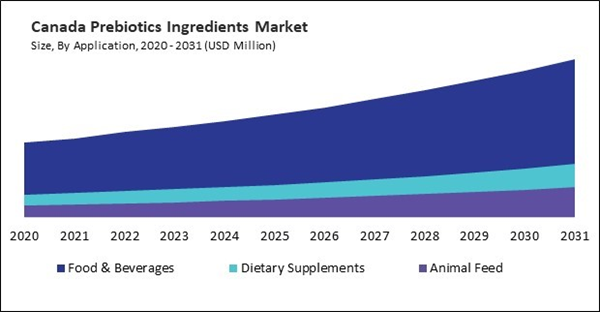The US market dominated the North America Prebiotics Ingredients Market by Country in 2023, and would continue to be a dominant market till 2031; thereby, achieving a market value of $2,565.3 million by 2031. The Canada market is experiencing a CAGR of 7.8% during (2024 - 2031). Additionally, The Mexico market would exhibit a CAGR of 6.8% during (2024 - 2031).
Prebiotic ingredients are frequently used to formulate nutraceuticals and dietary supplements targeting digestive health. Prebiotic fibers, including inulin, oligosaccharides, and resistant starch, are commonly found in these supplements. These fibers support the growth of beneficial gut bacteria and improve gut health overall. Prebiotic ingredients are utilized in animal feed to promote the health and growth of livestock, poultry, and aquaculture species. By incorporating prebiotics into animal diets, producers can enhance nutrient absorption, enhance immune function, and lower the incidence of digestive disorders. This contributes to better overall animal health and productivity.
Prebiotic ingredients are increasingly incorporated into personal care and cosmetic products owing to their potential benefits for skin health. Prebiotics can improve skin barrier function, hydration, and general skin health by supporting the skin's microbiome and fostering a balanced population of beneficial bacteria. For instance, according to a report by the National Library of Medicine updated in 2022, the ecologically based cosmetics industry is projected to reach $5.25 billion by 2029, expanding at a compound annual growth rate of 5.18% from 2019 to 2029.
According to the Canadian Institute for Health Information, Canada's senior population of those 65 and older will expand by 68% over the next 20 years. It has more than tripled in size in the last 40 years. In 2017, it was around 6.2 million. It is anticipated to reach 10.4 million in 2037. Hence, the factors mentioned above will drive the regional market growth.
Based on Application, the market is segmented into Food & Beverages, Dietary Supplements, and Animal Feed. Based on Ingredient, the market is segmented into Inulin, Galacto-Oligosaccharides, Fructo-Oligosaccharides, and Galacto-Fructose. Based on Source, the market is segmented into Cereals, Vegetables, Roots, and Others. Based on countries, the market is segmented into U.S., Mexico, Canada, and Rest of North America.
List of Key Companies Profiled
- Beneo GmbH (Sudzuker AG)
- Cargill, Incorporated
- Roquette Freres SA
- Royal FrieslandCampina N.V.
- Ingredion Incorporated
- Jarrow Formulas, Inc.
- Nexira, Inc.
- COSUCRA Groupe Warcoing S.A.
- Cooperatie Koninklijke Cosun U.A. (Royal Cosun)
- Yakult Honsha Co., Ltd.
Market Report Segmentation
By Application- Food & Beverages
- Dietary Supplements
- Animal Feed
- Inulin
- Galacto-Oligosaccharides
- Fructo-Oligosaccharides
- Galacto-Fructose
- Cereals
- Vegetables
- Roots
- Others
- US
- Canada
- Mexico
- Rest of North America
Table of Contents
Companies Mentioned
- Beneo GmbH (Sudzuker AG)
- Cargill, Incorporated
- Roquette Freres SA
- Royal FrieslandCampina N.V.
- Ingredion Incorporated
- Jarrow Formulas, Inc.
- Nexira, Inc.
- COSUCRA Groupe Warcoing S.A.
- Cooperatie Koninklijke Cosun U.A. (Royal Cosun)
- Yakult Honsha Co., Ltd.
Methodology

LOADING...









